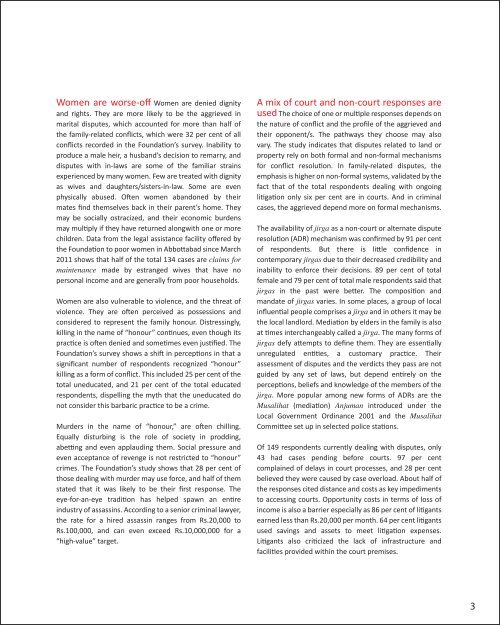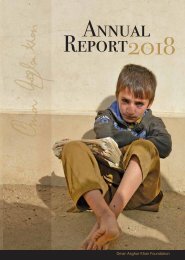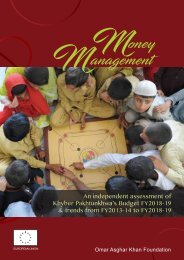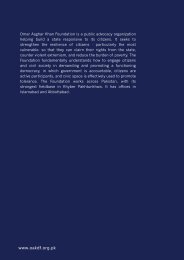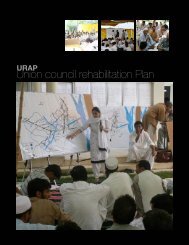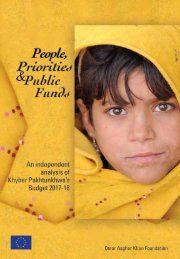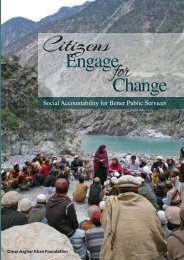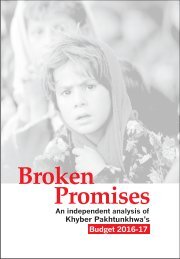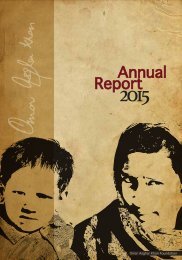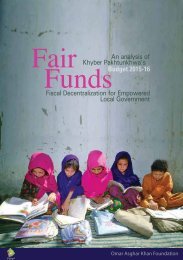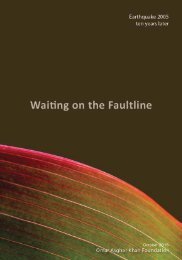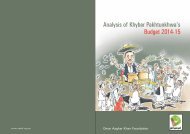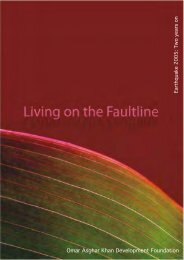Justice Denied
Create successful ePaper yourself
Turn your PDF publications into a flip-book with our unique Google optimized e-Paper software.
Women are worse-off Women are denied dignity<br />
and rights. They are more likely to be the aggrieved in<br />
marital disputes, which accounted for more than half of<br />
the family-related conflicts, which were 32 per cent of all<br />
conflicts recorded in the Foundation’s survey. Inability to<br />
produce a male heir, a husband’s decision to remarry, and<br />
disputes with in-laws are some of the familiar strains<br />
experienced by many women. Few are treated with dignity<br />
as wives and daughters/sisters-in-law. Some are even<br />
physically abused. Often women abandoned by their<br />
mates find themselves back in their parent’s home. They<br />
may be socially ostracized, and their economic burdens<br />
may multiply if they have returned alongwith one or more<br />
children. Data from the legal assistance facility offered by<br />
the Foundation to poor women in Abbottabad since March<br />
2011 shows that half of the total 134 cases are claims for<br />
maintenance made by estranged wives that have no<br />
personal income and are generally from poor households.<br />
Women are also vulnerable to violence, and the threat of<br />
violence. They are often perceived as possessions and<br />
considered to represent the family honour. Distressingly,<br />
killing in the name of “honour” continues, even though its<br />
practice is often denied and sometimes even justified. The<br />
Foundation’s survey shows a shift in perceptions in that a<br />
significant number of respondents recognized “honour”<br />
killing as a form of conflict. This included 25 per cent of the<br />
total uneducated, and 21 per cent of the total educated<br />
respondents, dispelling the myth that the uneducated do<br />
not consider this barbaric practice to be a crime.<br />
Murders in the name of “honour,” are often chilling.<br />
Equally disturbing is the role of society in prodding,<br />
abetting and even applauding them. Social pressure and<br />
even acceptance of revenge is not restricted to “honour”<br />
crimes. The Foundation’s study shows that 28 per cent of<br />
those dealing with murder may use force, and half of them<br />
stated that it was likely to be their first response. The<br />
eye-for-an-eye tradition has helped spawn an entire<br />
industry of assassins. According to a senior criminal lawyer,<br />
the rate for a hired assassin ranges from Rs.20,000 to<br />
Rs.100,000, and can even exceed Rs.10,000,000 for a<br />
“high-value” target.<br />
A mix of court and non-court responses are<br />
used The choice of one or multiple responses depends on<br />
the nature of conflict and the profile of the aggrieved and<br />
their opponent/s. The pathways they choose may also<br />
vary. The study indicates that disputes related to land or<br />
property rely on both formal and non-formal mechanisms<br />
for conflict resolution. In family-related disputes, the<br />
emphasis is higher on non-formal systems, validated by the<br />
fact that of the total respondents dealing with ongoing<br />
litigation only six per cent are in courts. And in criminal<br />
cases, the aggrieved depend more on formal mechanisms.<br />
The availability of jirga as a non-court or alternate dispute<br />
resolution (ADR) mechanism was confirmed by 91 per cent<br />
of respondents. But there is little confidence in<br />
contemporary jirgas due to their decreased credibility and<br />
inability to enforce their decisions. 89 per cent of total<br />
female and 79 per cent of total male respondents said that<br />
jirgas in the past were better. The composition and<br />
mandate of jirgas varies. In some places, a group of local<br />
influential people comprises a jirga and in others it may be<br />
the local landlord. Mediation by elders in the family is also<br />
at times interchangeably called a jirga. The many forms of<br />
jirgas defy attempts to define them. They are essentially<br />
unregulated entities, a customary practice. Their<br />
assessment of disputes and the verdicts they pass are not<br />
guided by any set of laws, but depend entirely on the<br />
perceptions, beliefs and knowledge of the members of the<br />
jirga. More popular among new forms of ADRs are the<br />
Musalihat (mediation) Anjuman introduced under the<br />
Local Government Ordinance 2001 and the Musalihat<br />
Committee set up in selected police stations.<br />
Of 149 respondents currently dealing with disputes, only<br />
43 had cases pending before courts. 97 per cent<br />
complained of delays in court processes, and 28 per cent<br />
believed they were caused by case overload. About half of<br />
the responses cited distance and costs as key impediments<br />
to accessing courts. Opportunity costs in terms of loss of<br />
income is also a barrier especially as 86 per cent of litigants<br />
earned less than Rs.20,000 per month. 64 per cent litigants<br />
used savings and assets to meet litigation expenses.<br />
Litigants also criticized the lack of infrastructure and<br />
facilities provided within the court premises.<br />
3


